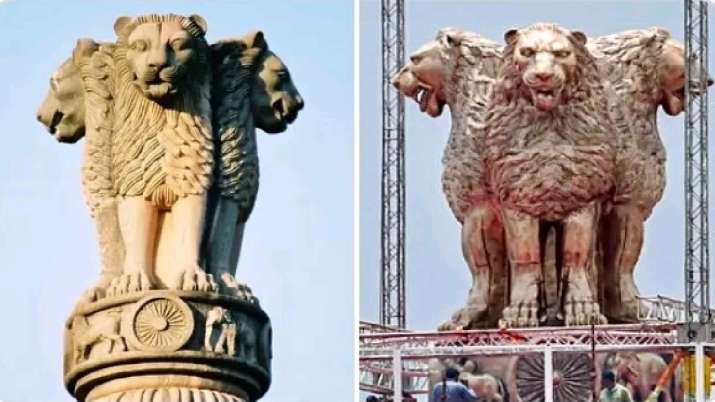ForumIAS announcing GS Foundation Program for UPSC CSE 2025-26 from 19 April. Click Here for more information.
ForumIAS Answer Writing Focus Group (AWFG) for Mains 2024 commencing from 24th June 2024. The Entrance Test for the program will be held on 28th April 2024 at 9 AM. To know more about the program visit: https://forumias.com/blog/awfg2024
Source: The post is based on the article “Explained| Why is there outrage over the new ‘National Emblem’?” published in The Hindu on 20th July 2022.
What is the News?
The Prime Minister has given India a first glimpse of the national emblem atop the new Parliament House coming up as part of the Central Vista Project.
What is the history behind the National Emblem?
The National Emblem is an adaptation from the Sarnath Lion Capital of Ashoka which is preserved in the Sarnath Museum.
It was built in 250 BC to commemorate the first sermon of Gautama Buddha, where he is said to have shared the Four Noble Truths of life.
This pillar was part of Asoka’s plan to spread Buddha’s teachings. After the large-scale massacre in the Battle of Kalinga, Asoka was shaken and embraced Buddhism with its emphasis on ahimsa. He decided to propagate his principles throughout his empire through the Major and Minor Edicts.
Features: The Lion Capital has four lions mounted back-to-back on a circular abacus. The frieze of the abacus is adorned with sculptures in high relief of an elephant, a galloping horse, a bull and a lion separated by intervening Dharma Chakras.
– The four animals are said to be guardians of the four directions — north, south, east and west.
– They are separated by a wheel, representing the Dharmachakra of Buddhism, on all four sides. Each chakra or wheel has 24 spokes. The chakra was later adopted as part of the national flag. This abacus was mounted on an inverted lotus which is a symbol of Buddhism.
Foreign Traveller: Chinese traveller Hiuen Tsang has left a detailed account of Asoka’s lion pillar in his Writings.
Why did the Constituent Assembly adopted Sarnath Pillar as the National Emblem?
As India won independence, the Constituent Assembly decided on the Sarnath pillar as the national emblem. It was felt that the pillar epitomized the power, courage and confidence of the free nation.
The emblem depicts a two-dimensional sculpture with the words Satyameva Jayate (truth alone triumphs) written below it, taken from the Mundaka Upanishad, written in Devanagari script.
On January 26, 1950, the Lion Capital of Ashoka at Sarnath officially became the national emblem of India. Five students of renowned artist Nandalal Bose created the emblem.
What is the controversy behind the latest replica of the National Emblem?

The national emblem atop the new Parliament House is designed by Sunil Deore and Romiel Moses.
Many alleged that the lion in this National Emblem replica looked “too aggressive” which amounted to tampering with the original emblem.
However, the designers countered the criticism about the lions looking aggressive by insisting that it was a matter of perspective, and claimed that the new emblem is a huge structure meant to be appreciated from a distance.




